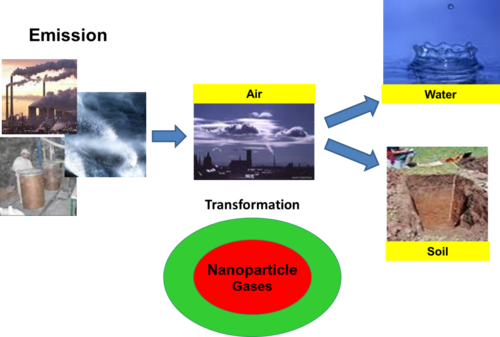WP6
Effect of ENM form on environmental fate in air
Lead: Carmen Nickel, IUTA e.V., Air Quality & Sustainable Nanotechnology Unit
Nanomaterials may become airborne during different phases of the product life cycle. Models describing transport and deposition of particulate materials from air are already relatively well established1. However, to date the specific relevance of these models for ENMs has not been fully validated2. In particular, the extent to which the processes that can transform ENMs in the environmental "reactor" of the atmosphere are relevant to their ultimate fate and bio-uptake is not clear. The transformation of airborne ENMs during atmospheric transport will change their surface properties and hence their mobility and possibly toxicity. Thus these processes have to be included in such models. NanoFASE studies these processes in field and laboratory studies and develops corresponding atmospheric models of ENM transport and deposition beyond the current state of the art . To do this, reactions modifying or degrading the surface coating or functionalisation during airborne transport are assessed using ENMs from the test set in the laboratory.

Scheme depicting the main effect of the airborne phase of nano-objects in the environment and its possible implication for transport and transformation. Nano-objects in air may have a direct impact in atmospheric chemical reactions by catalysing e.g. oxidation processes. Nano-objects may also be altered by chemical reactions, photo-degradation of coatings or dissolution in cloud droplets.
Agglomeration and deagglomeration, both between ENMs and with other airborne particulates during atmospheric transport, as well as the condensation of airborne constituents such as semi-volatile organic compounds, are studied to gain information on size distributions and heteroagglomeration rates, as was shown to be feasible for workplace environments 3. These processes can only be investigated in designed field tests as foreseen for traffic and production related ENMs. The field test campaigns in NanoFASE therefore cover investigations of ENM transport and transformation as well as their effective concentration in air, water, sediments and soils, a) in the vicinity of the selected plant (jointly with WP4), and b) at the selected traffic emission site. The studies from release to the near field environment are a unique opportunity to quantify and assess these ENM fate processes in a real environment, also facilitating evaluation of the corresponding models.
Furthermore, some ENMs are known to be (photo-catalytically) active and their presence in ambient air will alter the ENM surface chemistry significantly, but this has not yet been investigated. Selected investigations under relevant UV-light conditions are conducted by NanoFASE to assess the possible implications for the first time. Our studies focus on emissions to ambient air and outdoor processes, building as much as possible on the experience obtained from workplace related release and exposure studies such as those in MARINA, PEROSH, and NanoSafe.
Identifying and understanding the main physical and chemical transformations (e.g. coating modification, agglomeration, charge) of ENMs in air enables us to model these processes and how the transformations affect deposition fluxes (dry and wet) of airborne ENM, their fluxes from air to soil (WP7) and surface waters (WP8), as well as their potential for direct environmental exposures. NanoFASE provides for the first time a model describing these relevant processes for ENMs.
